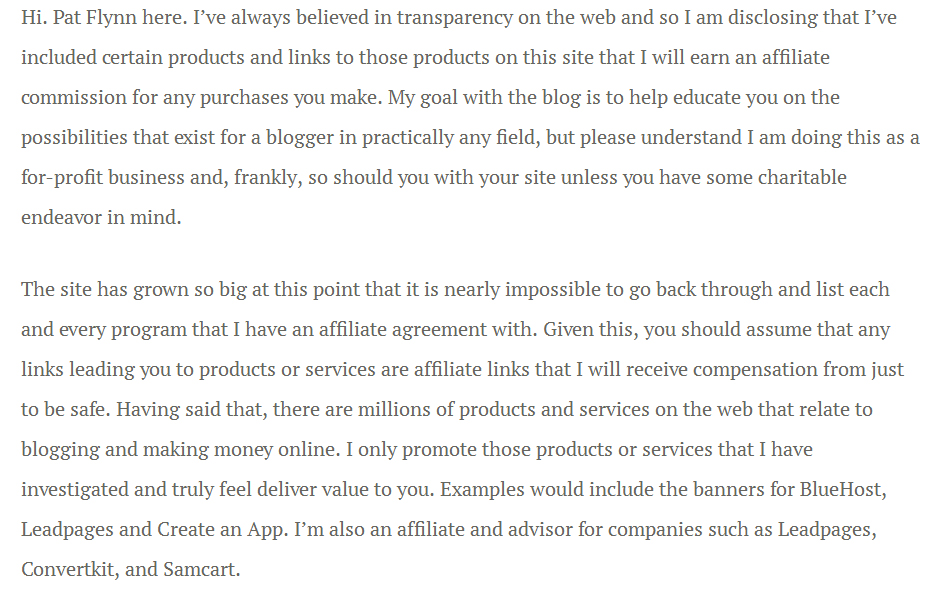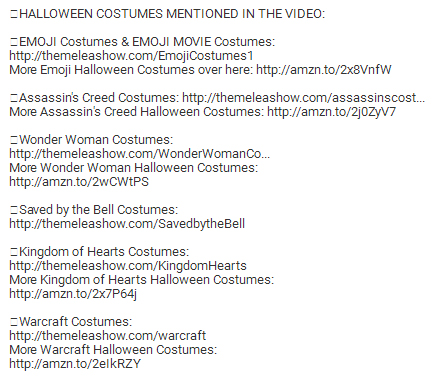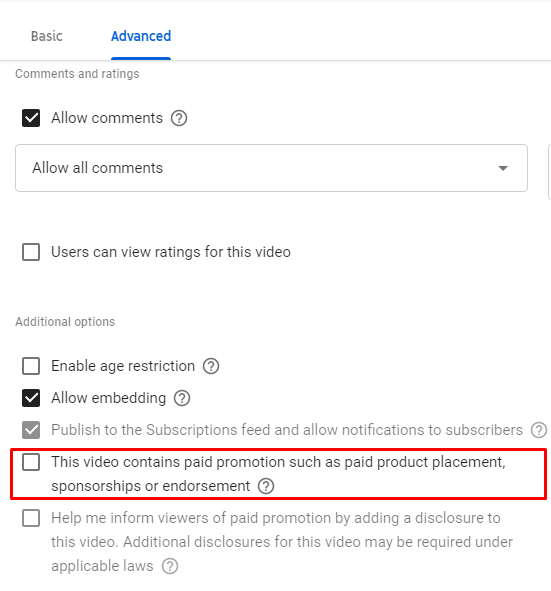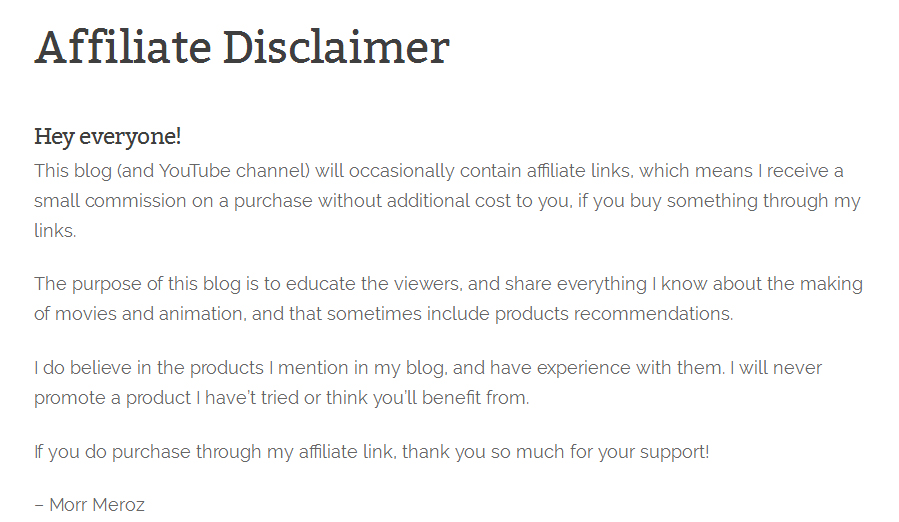Affiliate Disclaimers in YouTube Videos
Ready to become the next YouTube sensation? Or maybe you'd rather make your affiliate products the star so that you can earn some extra money.
YouTube is a great tool for affiliate marketers because it's one of the biggest search engines in the world. In just one minute, 300 hours worth of video are uploaded! Once the day is over, YouTube viewers will have watched a whopping five billion videos. And every single day, 30 million people visit YouTube.
With numbers like that, it's easy to see why you want to include YouTube videos in your affiliate marketing strategy.
But no matter what you say, look like, or do in your YouTube videos, if you're planning on selling affiliate products through them, you need an affiliate disclaimer. Without one, you can run into some major headaches.
What is an Affiliate Disclaimer?
It's a formal statement that explains your relationship to the affiliate products you're talking about in your digital content.
In the US, the Federal Trade Commission (FTC) has guidelines that you have to follow if you're an affiliate marketer. Specifically, you have to publish a disclaimer that's clear and conspicuous so that your readers/viewers/listeners/followers know that you'll receive a commission payment if they click on any of your affiliate links and make a purchase.
You'll also need to use an affiliate disclaimer if you've received other forms of compensation like free products or payment in exchange for writing certain blog posts.
In other words, the FTC wants to make sure everyone is on the same page.
Here's an example of a clear and conspicuous affiliate disclaimer from Pat Flynn's website, Smart Passive Income:

Yes, this affiliate disclaimer is a little long, but it's easy to understand. Pat Flynn has used very conversational language to explain how he makes money from affiliate programs and he even encourages his readers to do it, too.
One of the most important parts of this affiliate disclaimer is where Flynn writes that, "I only promote those products that I have investigated and truly feel deliver value to you." That way, it's clear to readers that Flynn has their best interest at heart, and that he's not willing to hype up any old product just to make a quick buck.
The FTC isn't the only entity that requires affiliate disclaimers, though. Many of the big affiliate programs, including Amazon, require that you use specific language in your affiliate disclaimer. If you skip the disclaimer, you can be kicked out of the program and lose all of your commission payments.
So how does all of this relate to your YouTube videos?
Videos are a great way to show off your affiliate products because they feel much more interactive than a blog post or a social media blurb. Or, if you like to review different affiliate products for your audience, they can watch you use the product instead of just reading your description of how the product works.
However, the FTC requires affiliate disclaimers on YouTube videos, too. And that's where things can get a little tricky.
Unlike your blog, there's no way to create a dedicated affiliate disclaimer page on your YouTube channel. If you post a long full-screen affiliate disclaimer before your video begins, viewers might grow impatient and leave your channel altogether.
If you want to make the FTC and your YouTube viewers happy, follow these do's and don'ts:
- DON'T just plop an affiliate disclaimer in the description of each YouTube video
This might seem like the easiest way to adhere to the FTC's guidelines and give your viewers a heads up, but there's a big problem with disclaiming this way: That description isn't included on embedded videos.
Remember, your YouTube videos can be shared all over the world wide web. However, when someone embeds your video on their website, the description doesn't come along with it. As a result, any disclaimer that you may have carefully written in your description box isn't available for your embedded viewers.
For example, this is some of what Melea from YouTube channel "The Melea Show" included in her description box for a video about Halloween costumes:

Look closely and you'll see that each costume has a link that starts with "http://amzn.to" which is how Amazon affiliate links are shortened, so the link to each costume listed here is an affiliate link that Melea will make a commission off of.
But if someone decides to embed Melea's video on their own festive Halloween website, none of these links are going to be available. In other words, make sure that you're OK with "losing" the information in your description box. If there's anything you need to carry over to an embedded video, you'll need to put it somewhere else, or someplace in addition to your description box.
- DON'T ignore your affiliate disclaimer and assume you won't get caught
A study at Princeton University showed that 90% of the affiliate links on YouTube and Pinterest aren't properly disclosed. To come up with this whopping number, the researchers at Princeton analyzed more than 500,000 YouTube videos.
According to the Princeton researchers, some video publishers did include some kind of teeny-tiny mention, like the hashtag "#affiliatelink" in the description or simply posting "Amazon link" next to the affiliate link. This isn't good enough, though.
- DO use an explanation affiliate disclaimer
Neither of the disclaimers that we just mentioned are good enough for the FTC. For starters, neither is clear and conspicuous. Even if you have "AMAZON LINK" in bold, bright red letters in your video, viewers likely won't understand why it's there. After all, there are millions of Amazon links, and not all of them are affiliate links.
Plus, calling a link an affiliate link isn't clear either. Lots of viewers don't know how affiliate marketing works, so they don't understand that you'll be compensated if they make a purchase through one of your product links.
If you want to adhere exactly to the FTC's guidelines, you need to include an explanation affiliate disclaimer. Simply say something in your video like, "This video contains affiliate links. If you click on one of them, I'll receive a commission."
Not only will this ensure that your viewers know about your relationship to the product, but this disclaimer will be included anywhere that your video is embedded because it's part of the video itself.
According to the Princeton study, only 1.82% of the affiliate videos on YouTube contained a proper explanation disclaimer. If you're inclined to skip an explanation affiliate disclaimer because more than 98% of YouTube's other affiliate marketers are skipping it, don't. Even if YouTube doesn't crack down on you, your viewers might if they learn you're making money off their link clicks without telling them.
If a viewer thinks you're providing genuine information, for free, out of the goodness of your heart, they may be angry to learn that you're actually receiving a commission. It's easy for a viewer to report your video. All they have to do is check the box that says "Unwanted commercial content or spam."
If enough viewers report you, you could lose your entire YouTube channel. Plus, if your viewers are clicking this box, they're never going to listen to anything you say ever again. So do yourself a favor and create a crystal clear affiliate disclaimer.
- DO remember that YouTube has its own rules that you have to follow
The FTC isn't the only entity you have to please when you're marketing affiliate products in your YouTube videos. YouTube also has policies that you must adhere to.
- DO check the "Paid Product Placement" box when you upload your videos
The next time you upload a video with affiliate links, head over to the Advanced tab and check the box that says "This video contains paid promotion such as paid product placement, sponsorships or endorsement."

YouTube's Terms of Service allow you to make money from your videos as long as you notify them first, and this is how you notify them. Even if you're only receiving a tiny commission from your affiliate links, you're still using your YouTube video to make money. You'd rather be safe than sorry, right?
- DO sign up for YouTube's Partner Program
If you want your video's end card to link to an external website (which is exactly what you're doing with affiliate links), you're required to sign up for YouTube's Partner Program. This rule was established in late 2017, and YouTube says the rule was created so that they can evaluate the validity of the channel and make sure that the videos aren't linking to anything that violates their Community Guidelines.
This is a big deal because end cards are so important to affiliate marketers. After all, they're full-screen graphics that can contain all kinds of important information.
- DO consider mentioning your YouTube channel on your blog
If you already have an affiliate disclaimer page on your blog, add a small comment about your YouTube channel to it.
Here's how the owner of Bloop Animation did it:

Mentioning your YouTube affiliate links on your blog doesn't excuse you from putting an affiliate disclaimer on your YouTube videos, but it's a good way to show people that you're being upfront with them.
- DON'T think you can ignore all of this just because you don't live in the United States
If you think that the FTC's guidelines don't apply to you because you live in another country, think again. According to the FTC's What People Are Asking page, if it's "reasonably foreseeable" that American consumers will see your YouTube videos or if the products you're promoting are sold in the US then you're responsible for creating a proper affiliate disclaimer. Plus, as the FTC points out, the UK and several other countries have similar disclaimer guidelines.
Affiliate disclaimers for your YouTube videos don't have to be complicated. When in doubt, just be honest with your audience!
Put yourself in the shoes of one of your viewers and ask yourself what you would like to know. Be sure to give all of the necessary details in a way that's short, sweet, and to the point. Forget about confusing legal jargon, and simply talk to your audience. After all, they're on your YouTube channel because they want to know what you have to say.